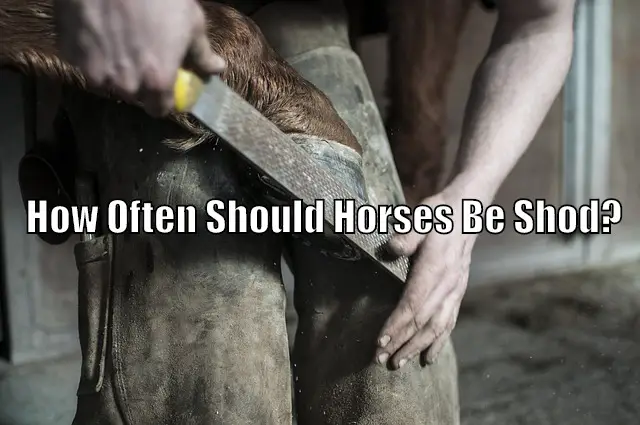We all want the comfort for our horses because a happy horse means a happy companion and lower expenses. However, you do not want to be caught doing more than you should. I am a horse enthusiast and always wanted to be up to date with maintenance of my horse until I met an experienced farrier who gave me useful information I believe will be of use to all horse lovers.
So how often should horses be shod? According to expert opinion, you should trim or shoe your horse every four to six weeks regardless of whether they have shoes or not. Since hooves are continuously growing, they should be shod frequently to keep the horse comfortable and renewed.
Keep Up With The Horseshoes
Most newcomers keep up with the 6-week duration to complete the process. Older horse owners are somewhat neglecting and will not keep up with this progress mostly because of the cost and getting used to the process. It is natural to get lazy on maintenance sometimes but considering the health and wellness of your horse, you should always allow the farrier to refurbish your horses’ hooves.
Corrective re-shoeing gets it back to where it is meant to be. Since shoes are artificial, the horse needs the readjustments to find the right degree of angle. Repair of the crumbly, dry, splits, cracks, and chunks from the torn hoof helps restore comfort to your horse especially on adult horses.
The importance of re-shoeing is to avoid foot deterioration hence the need for an experienced farrier to do a perfect job. A good job on your horse’s foot will improve its health and avoid further injuries. You will also ride comfortably on tough terrains without hurting your horse.
Shoed horses require maintenance and attention. If you have installed shoes on your horse, congratulations; you have done a great job but it does not stop here. Leaving them on will put your horse at risk of underrun heels, cracks, thrush, long toes, and contracted heels.
The reason is after some time, the hoof grows making the horse to walk uncomfortably especially on surfaces, which file it downwards. When the walk is not natural, you are late; call your farrier immediately to solve the problem.
When to know your Horse Shoe requires Maintenance
Although your farrier’s visit should be every six weeks, you should learn to observe the telltale signs as a rule of thumb. There are several signs to watch out for to give you a leeway to make a quick decision. you should not wait until you notice the bad signs, which indicate a suffering horse.
This means you waited too long. Here are some signs to indicate you need the services of a farrier faster than you may be planning to wait:
- A shoe becomes loose or comes off altogether
- Loose nails, which tend to push up from the hoof wall
- Nails protruding further out of the shoe especially on the underside than when they were initially installed
- The hoof is starting to overgrow the shoe and is getting out of shape
- If the shoe has become excessively thin or unevenly worn
- If it seems twisted on the foot making the horse uncomfortable
Beware that some of these signs may appear prematurely. For example, you may notice a twist or wear and a loosen nails before 6 weeks elapse. They do not necessarily mean you are negligent.
The six-week rule is therefore, a general recommendation for most horses on average. You may have to find quicker solutions before this time elapses.
The Re-shoeing Process
Your farrier will set aside the old shoes, trim the hoof growth off, shape it, and nail the same shoes back on. Without natural wear on the hoof (like if they were on bare feet), the hoofs may grow faster, as there is little interference. In this case, your farrier will reshape the shoes to correct the problem.
As long as there is no excessive wear to the metal, the shoes can be reset and work effectively. Their durability depends on the activity and terrain. They will need frequent re-setting if you ride over abrasive surface live rock but will last months if you walk on grass.
You should ensure you are prepared to handle emergencies by calling your vets immediately. Learn first-aid practices to keep your horse comfortable before they get the attention of practitioners.
Related Questions
Do small-sized less active ponies also need frequent re-shoeing?
Yes, all horses have a right to get their hooves fixed to allow them live a longer fulfilling life
How frequent should a vet visit?
You need to have emergency numbers of your vets. However, they should visit once a year to check on the horses and provide adequate medical care. Older horses need more frequent visits. Make sure they are getting their yearly shots and worming them when they need it to keep them healthy.
What should I do for emergencies of Horse losing a shoe?
Call your farrier immediately and avoid further activity until the shoe is restored. Bring them in a stall to limit their movement. Check to make sure there are no nails exposed. If so you may want to at least clip the sharp edge or we have actually used duck tape before until the ferrier arrived. Anything to keep them from hurting themselves.
Conclusions
Consult a farrier and Vet to help you get the best advice on re-shoeing. You do not want to keep the horse suffering in ignorance. Most importantly, never let your horse walk in the same shoes for months regardless of how inactive they may be. The shoes will damage the hoofs completely.
As long as you keep up with things and there are treatments for their hooves you can put on to keep them stronger. Also if where you are it rains a lot this will help with that matter as well. Never neglect things if you keep ahead your horse will be happier and your vet bills will be near non-existent except for their yearlies.


